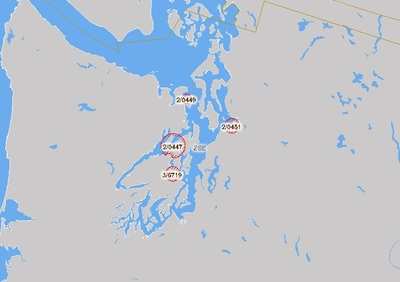Meeting Contributes To Further Reduction In TFR Size
Following a meeting between AOPA President Phil Boyer and
high-ranking U.S. Navy officials that helped define concerns on
both sides of the issue and correct some original mistakes, the FAA
has reduced the size of two security-related temporary flight
restrictions in the Puget Sound area of Washington State. EAA also
had a major hand in making this revision a reality.
The change at Bangor (FDC NOTAM 4/2125) moves the southern
boundary north and lessens the impact to and from Apex Airpark. At
Port Townsend (FDC NOTAM 4/2126), the new boundary lessens the
impact on pilots operating out of Jefferson County International
Airport.
"Rear Adm. Mark Fitzgerald, the Navy's director of Air Warfare,
made clear that the Navy considers all four areas in the Puget
Sound highly sensitive and unique and will continue to demand TFRs
over them," said Boyer. "At the same time we were able to lay out
the impacts these TFRS have on civilian pilots."
AOPA has worked closely with Sen. Patty Murray (D-WA) and Sen.
Maria Cantwell (D-WA), as well as representatives Rick Larsen
(D-WA) and Jennifer Dunn (R-WA), to remove or at the very least
minimize the impact of the security-related TFRs imposed in the
immediate aftermath of the September 11 terrorist attacks. Relying
on information and advocacy efforts by local pilots, the
association has also made the case at the highest levels of the
Navy, including the chief of Naval Operations.
EAA government and industry relations staff worked with the
local EAA members and Chapters, state aeronautics division, the
U.S. Navy, and Homeland Security officials in pushing for the
reduction. EAA's research and analysis department surveyed nearly
3,000 EAA members in Washington and northern Oregon in November
2003 and found that the TFRs were having significant negative
impact on area pilots and businesses. Safety was a main concern,
citing increased anxiety, traffic, frequent occurrence of adverse
weather, and narrow flight corridors. Local airports and related
businesses experienced diminished economic activity as a result of
the TFRs, although a comprehensive economic impact study was not
conducted.
Barbara Tolbert, EAA member and Executive Director of the
Northwest EAA Regional Fly-In at Arlington, applauded the
reductions. "Pilots will welcome this news," she said. "The height
and size of the TFR essentially shut down one of the two corridors
VFR pilots used in the Puget Sound area."
Congressman Rick Larsen (D-WA) has taken an active role in the
push to remove the TFRs. "Today's FAA announcement that the TFRs
over Bangor and Port Townsend are shrinking takes us two steps
forward and will improve pilots' accessibility and safety," he said
Tuesday (March 16). "From the beginning, I encouraged the Navy to
sit down with local pilots and address their legitimate concerns. I
am pleased we are seeing results from those conversations, and I
will continue to work with all the stakeholders on this important
issue."

Tolbert said that during the 2002 Arlington fly-in she and EAA
member pilot Bruce Angell had the opportunity to take Congressman
Larsen up for firsthand look at what pilots had to deal with
regarding the TFRs. Larsen, who serves on the Aviation Subcommittee
of the House Committee on Transportation and Infrastructure, was
eventually able to arrange a dialogue between Rear Admiral Leendert
R. Hering, Sr., Commander, Navy Region Northwest, and Washington
pilots to discuss the TFRs. Last November, Larsen asked Defense
Secretary Donald Rumsfeld to "take a good, long look at these
costly, outdated TFRs that are hurting our pilots and aviation
businesses."
The Puget Sound TFRs are only four of 13 security-related TFRs
spread across the country, but because of their close proximity to
each other, they've had a disproportionate impact on general
aviation in the Seattle/Puget Sound area.
 ANN's Daily Aero-Term (05.29.25): Terminal Radar Service Area
ANN's Daily Aero-Term (05.29.25): Terminal Radar Service Area ANN's Daily Aero-Term (05.30.25): Very High Frequency (VHF)
ANN's Daily Aero-Term (05.30.25): Very High Frequency (VHF) Aero-News: Quote of the Day (05.30.25)
Aero-News: Quote of the Day (05.30.25) Airborne 05.23.25: Global 8000, Qatar B747 Accepted, Aviation Merit Badge
Airborne 05.23.25: Global 8000, Qatar B747 Accepted, Aviation Merit Badge ANN's Daily Aero-Linx (05.30.25)
ANN's Daily Aero-Linx (05.30.25)



